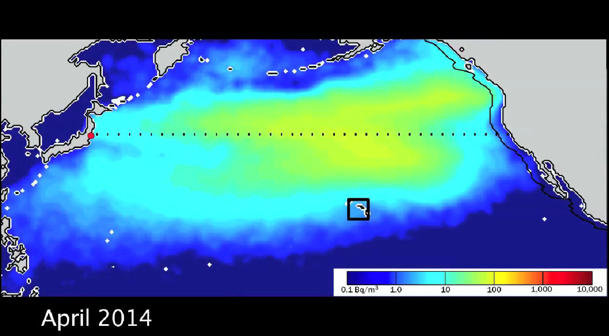
This computer model of the Fukushima radiation plume shows its expected progress across the Pacific Ocean. Vancouver, British Columbia
Fukushima forecast used by gov’t shows nuclear waste crossing ocean in single massive cluster — “Maximum concentration propagates eastward in Pacific toward U.S.” — Highest levels worldwide remain along coast of N. America through 2026 (VIDEO)
ENENews
Nansen Environmental and Remote Sensing Center (Norway), 2013 (emphasis added): The massive nuclear leakage into  ocean from Fukushima Nuclear Power Plant was observed on March 25th,2011. The transport of leaked radioactive pollutant from the Fukushima Nuclear Power Plant was simulated… assuming constant and continuous leakage for 20 days (scenario 1) and for one year(scenario 2) starting from March 25th, 2011 and was integrated for 20 years… There is no remarkable difference of transport pathways… for the nuclear waste… The results of the ensembles indicate that the nuclear pollutant for both scenarios transports eastward to eastern Pacific… It takes about 10 to 15 years to reach the coast of East Asia… a realistic source
ocean from Fukushima Nuclear Power Plant was observed on March 25th,2011. The transport of leaked radioactive pollutant from the Fukushima Nuclear Power Plant was simulated… assuming constant and continuous leakage for 20 days (scenario 1) and for one year(scenario 2) starting from March 25th, 2011 and was integrated for 20 years… There is no remarkable difference of transport pathways… for the nuclear waste… The results of the ensembles indicate that the nuclear pollutant for both scenarios transports eastward to eastern Pacific… It takes about 10 to 15 years to reach the coast of East Asia… a realistic source function is required and atmospheric fallout and role of ocean ecology should also be taken into account, in order to get a more reliable assessment of possible impact of the radioactive leakage on the ocean environment.
function is required and atmospheric fallout and role of ocean ecology should also be taken into account, in order to get a more reliable assessment of possible impact of the radioactive leakage on the ocean environment.
Nansen Environmental and Remote Sensing Center, Prof. Ola Johannessen, University of Bergen Geophysical Institute: Ocean spreading of radioactivity from the Fukushima nuclear plant in Japan […] The results show that the maximum concentration propagates eastward in the Pacific toward the United States during a 7-year period while the total concentration drops to 1-2% of the source concentration (100%) after 5 years.
Nansen-Zhu International Research Centre, China: Extraordinary earthquake hit Japan and led the nuclear leakage of Japanese Fukushima reactor to the ocean. Dr. Yongqi Gao with colleagues at NERSC and NZC used the numerical model to simulate the propagation of radioactive elements in the ocean. Model system has been used for EU RADARC (Simulation scenarios for potential radioactive spreading in the 21st century from rivers and external sources in the Russian Arctic coastal zone, 2001-2003) and Norwegian Research Council supported project ARC (Arctic Radioactive Contamination, 2004-2006)… results were also cited by the State Council of China.